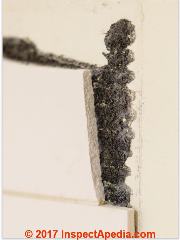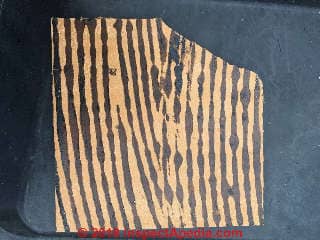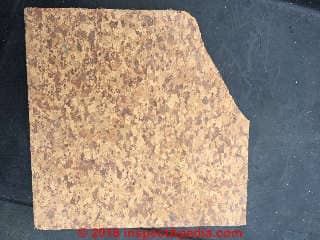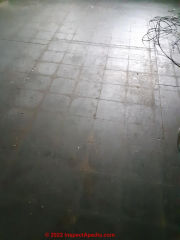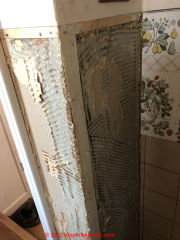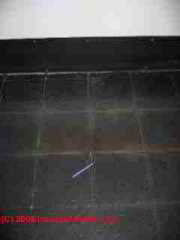 Asbestos-Containing Floor Tile Adhesive
Asbestos-Containing Floor Tile Adhesive
Mastic or Roofing Sealant Identification
- POST a QUESTION or COMMENT about the asbestos content in cutback adhesives & roofing mastics
How to recognize potentially hazardous roof or floor adhesive, mastic, or sealant that may contain asbestos.
This article provides dates of manufacture of asbestos-containing adhesives, mastics, sealants, and includes photographs and text describing the appearance of such products.
While an expert test by a certified asbestos testing lab is required for sure identification of the asbestos content of most materials, we point out that some materials can be recognized as asbestos-containing by simple visual inspection, and others may be treated as presumed asbestos containing products based on the product type, age, and or date of installation.
This article series answers questions about floor tile, sheet flooring, or roofing cutback adhesives or mastics that may contain asbestos.Does or did roofing mastic products & sealants contain asbestos?
What are the hazards of demolishing or working on floors or roofs where asphalt-based asbestos-containing mastics, cutback adhesives, or sealants were used? Page top photo of black mastic floor tile adhesive provided courtesy of reader G.M.
InspectAPedia tolerates no conflicts of interest. We have no relationship with advertisers, products, or services discussed at this website.
- Daniel Friedman, Publisher/Editor/Author - See WHO ARE WE?
Asbestos-Containing Floor Adhesive / Mastic Identification & Age
 Reader Question: when was asphalt-asbestos cutback adhesive manufactured & how can I Identify It
Reader Question: when was asphalt-asbestos cutback adhesive manufactured & how can I Identify It
When was asbestos asphalt cut back adhesive manufactured and is there an easy way to identify it? I have a house that was built in the mid 1970s and there is black adhesive on the kitchen floor. There was sheet linoleum over it. - C.H. New Jersey, 12/5/2012
Reply: how to decide if flooring mastic, cutback adhesive or similar products contain asbestos
A competent onsite inspection by an expert usually finds additional clues that help accurately diagnose a problem or hazard from handling cut-back adhesive or mastic that may contain asbestos in a flooring application as well as in roofing mastics. That said, here are some things to consider:
Dates of Black Asphalt-Based Asbestos-Containing Cutback Adhesive
Cutback is the black asphalt-based adhesive that was frequently used to install vinyl asbestos tile, asphalt tile and vinyl composition tile.
We're uncertain of its precise history, but we found it mentioned in a 1937 patent for composite panel board,
Patent number: 2232762
Filing date: Nov 27, 1937
Issue date: Feb 25, 1941
A patent by Vicenzi filed in 1986 describes an asbestos-free product intended for similar uses
Patent number: 4759799
Filing date: Aug 21, 1986
Issue date: Jul 26, 1988
So excluding time to move from patent into production, it seems reasonably safe to guess that asbestos-containing cutback adhesives were in use at least until that date, possibly a bit later.
Tan or Brown Latex-Based Tile Mastic / Adhesive - some might contain asbestos
Having examined asphalt-based adhesives used in floor tiles as well as in roofing mastics from a variety of installations, I cannot say that there is an easy way to recognize which contain asbestos and which do not simply by visual examination of the adhesive itself.
There are both dark and lighter tan tile or flooring adhesives that may look alike but be chemically very different - some can be softened by simple water, others not. However these related observations will be helpful:
- Floor installation date: Consider the probable date of application and use of the adhesive and assume that before 1988 it may have contained or was even likely to contain asbestos
- Floor covering materials: Consider the materials with which the cut-back adhesive was being used. For example, if the adhesive was used for asphalt-asbestos floor tiles or vinyl-asbestos floor tiles, then it would be reasonable to suspect the adhesive of also containing asbestos.
- Water-soluble tile mastics: Some floor tile mastics that appear difficult to remove using common solvents may in fact be water based and are removed by soaking with ordinary water; but beware that depending on age, these non-asphalt mastics may also have contained asbestos.
- Non-friable asbestos flooring mastics: Finally, where (most) asphalt based and other mastics and cut-back adhesives are generally not friable, the potential asbestos exposure hazard will be affected more by the means used to remove the material than by the material in its applied-state. Follow recommended wetting and cleanup guidelines.
Reader Question: Is it likely that this bath ceramic tile black mastic in my 1986 home would contain asbestos?
I posted a question in the Comments section regarding my bathroom Reno.
[Click to enlarge any image]
Shown here: reader's photos of ceramic bath tile and black tile mastic in a 1985-1986 Australian home.
My house is from 1985/86, the cement sheeting in the shower areas say “Manufactured With Asbestos”.
Before I remove the wall tile, I would like to know if there is any chance the adhesive could contain asbestos. I am sending images as requested.
Any information appreciated.
Although I can see some kind of fibre in the images, I have read that they can’t be seen without a microscope. Seems to be a lot of confusing info out there. - Anonymous by private email 2017/08/24
Reply: Australian & possibly some U.S. manufacturers stamped cement board as not made with asbestos in the late 1980's
In both the U.S. and Australia it would be unusual for new construction in 1985/6 to have used asbestos products but still possible, particularly some asbestos flooring products that remained in use into the end of that decade.
At the time of my initial reply I had not yet seen your photos of the mastic used behind ceramic bath tile, nor your backer board photo, so I offered this general advice: I'm not sure if you saw my note or if I was clear before about the possibility of asbestos in tile mastic.
See details at ASBESTOS PRODUCTS in AUSTRALIA
Typical Black Mastic Pattern on Vinyl-Asbestos Floor Tile Underside
Our photos above show a typical black floor tile adhesive mastic on the underside of a 9x9" cork-pattern vinyl floor tile found in a U.S. home built in 1960. Both the flooring and the mastic are likely to contain asbestos. These flooring photos were provided by an InspectApedia.com reader who wrote:
Hi, I just pulled up some tile in my dining room that was covered with laminate flooring. I’m now worried it is asbestos tile. It is 9 x 9 and our house was built in 1960.
Excerpts from our reply are below:
I see what looks like a cork pattern vinyl-asbestos floor tile with black mastic adhesive on the tile reverse.
You will find a match in the ID-library of asbestos flooring beginning at ASBESTOS FLOORING IDENTIFICATION - (floor tiles)
ADVICE: For buildings with floor tiles or sheet flooring that can be assumed to have been installed in North America before 1986 it would be prudent to treat the flooring as "PACM" or "Presumed Asbestos Containing Material".
The presence of known or assumed asbestos-containing flooring does not mean we should panic nor that we must undertake an expensive and dangerous asbestos removal project.
Asbestos is safe and legal to remain in homes or public buildings as long as the asbestos materials are in good condition and the asbestos can not be released into the air.
Generally the safest approach is to leave such flooring alone and to cover it over with a coating or with another layer of flooring.
See ASBESTOS FLOORING HAZARD REDUCTION
And also if you need to remove the floor, see ASBESTOS FLOORING REMOVAL GUIDE
IF you are faced with a requirement for demolition and if you are uncertain about the flooring's asbestos content and cannot identify it through our guides, then you have a sample tested.
...
Reader Comments, Questions & Answers About The Article Above
Below you will find questions and answers previously posted on this page at its page bottom reader comment box.
Reader Q&A - also see RECOMMENDED ARTICLES & FAQs
On 2022-05-24 by InspectApedia-911 (mod) - Cover old flooring with new is the best alternative if possible
@Ellie,
Possibly.
Leave alone, in place, cover-over or paint with the asbestos encapsulant we discuss in this article series.
Covering an asbestos-suspect floor material with new layers of underlayment (felt or paper) and new flooring is exactly what all expert sources recommend as both most safe and most economical.
On 2022-05-24 by Ellie
house was built around 1987; ceramic tile was lad over black paper and under paper appears to be an adhesive, black in color ... paper was removed and in some cases very clean wood, others where paper was matted not so much... asbestos?
my concern is that some paper was already removed (bc it got wet from a leak) .... subfloor will be covered with new paper and then new wood oak floor. Is that sufficient? Very concerned about air quality now and am unsure how to reverse this.
On 2021-12-27 by Inspectapedia Com Moderator
@John,
Thank you for that clarification.
I think the dates are good for for mastic adhesive as well, but I agree that the authoritative data on the date of last use of asbestos in mastic adhesive is a bit more thin.
On 2021-12-27 by John
@Inspectapedia Com Moderator, thank you. I was not sure if that rule of thumb applied to adhesives as well.
On 2021-12-27 by Inspectapedia Com Moderator
@John,
As you'll read in this article series, asbestos wouldn't be expected in U.S. flooring products past the mid 1980s.
On 2021-12-27 by John
Hi, my house was built in 1993 in the USA. The finished basement had a carpet with a felt underlayment. The underlayment was glued to the slab along the edges about 2 feet out from the wall with a brownish/light tan water soluble adhesive. Would you think that adhesive could contain asbestos ?
On 2021-05-07 by danjoefriedman (mod)
@Cindee zlacki,
Sure, see details at
ASBESTOS ENCAPSULANTS & SEALERS
On 2021-05-06 by Cindee zlacki
@danjoefriedman, Can you paint A sealer over the black and than lay a new carpet?
On 2021-04-02 by danjoefriedman (mod)
@Paul, unfortunately I don't think we can tell by looking at the tile mastic adhesive whether or not it contains asbestos. Asbestos was used in both black asphaltic adhesive and also in wider can gray and brown adhesive products. If you know when your tile was installed you could compare that with the date being used in your country.
If we're just talking mastic and if you can remove it without creating dust, as it's not friable, it's not particularly hazardous even if it contained asbestos.
On 2021-04-02 by Paul
Had the layers of vinyl and board glued on the wall tested but not sure if the lab looked at the glue itself. It looks like chocolate almost. What do you think?
If I sent it to a lab that was reputable with some of the glue on it do you think it would be safe to say that the all clear they gave me is enough to go on?
Also this was a fiber bird product with wallpaper and vinyl glue to it. On the wall. Not on a floor
On 2020-02-05 by danjoefriedman (mod)
Sorry Chris, I can't say.
Check out the easy questions at DOES THIS FLOOR CONTAIN ASBESTOS? https://inspectapedia.com/hazmat/DIY-Asbestos-Floor-Test.php
On 2020-02-05 by Chris
Do the black textured floor tiles pictured at the top of the page titled “Asbestos containing floor tile adhesive” contain asbestos?
Question:
AUTHOR:Anonymous (no email)
COMMENT:Thanks for the feedback. I’m pretty much of a neat freak so house has been cleaned many many times since flooring install. Would you expect that any asbestos would get airborne in the future from what I described? Thanks
Would new products that contain limestone be expected to contain any asbestos? The gritty paint I referenced in my previous post contains 20 percent limestone and had read that, at least in the past limestone could contain asbestos. Thanks
Reply:
Flooring made in North America after the mid 1980's at latest would not contain asbestos.
Limestone is not an asbestos material.
...
Continue reading at ASBESTOS-CONTAINING MASTIC DANGEROUS? or select a topic from the closely-related articles below, or see the complete ARTICLE INDEX.
Or see ASBESTOS MASTIC IDENTIFICATION FAQs - questions & answers posted originally at the end of this page
Or see these
Recommended Articles
- ASBESTOS FLOORING HAZARD REDUCTION
- ASBESTOS FLOORING LEFT IN PLACE
- MASTIC, CUTBACK ADHESIVE, FLASHING CEMENT ASBESTOS
Suggested citation for this web page
ASBESTOS MASTIC IDENTIFICATION at InspectApedia.com - online encyclopedia of building & environmental inspection, testing, diagnosis, repair, & problem prevention advice.
Or see this
INDEX to RELATED ARTICLES: ARTICLE INDEX to ASBESTOS HAZARDS
Or use the SEARCH BOX found below to Ask a Question or Search InspectApedia
Ask a Question or Search InspectApedia
Try the search box just below, or if you prefer, post a question or comment in the Comments box below and we will respond promptly.
Search the InspectApedia website
Note: appearance of your Comment below may be delayed: if your comment contains an image, photograph, web link, or text that looks to the software as if it might be a web link, your posting will appear after it has been approved by a moderator. Apologies for the delay.
Only one image can be added per comment but you can post as many comments, and therefore images, as you like.
You will not receive a notification when a response to your question has been posted.
Please bookmark this page to make it easy for you to check back for our response.
IF above you see "Comment Form is loading comments..." then COMMENT BOX - countable.ca / bawkbox.com IS NOT WORKING.
In any case you are welcome to send an email directly to us at InspectApedia.com at editor@inspectApedia.com
We'll reply to you directly. Please help us help you by noting, in your email, the URL of the InspectApedia page where you wanted to comment.
Citations & References
In addition to any citations in the article above, a full list is available on request.
- [1] EPA, U.S. Environmental Protection Agency, Asbestos in Your Home, web search 08/31/2011, original source: www.epa.gov/asbestos/pubs/ashome.html
- [22] "Resource4Mesothelioma, Mesothelioma Information and Legal Guide", web search 3/6/2012, original source: resource4mesothelioma.com/topics/whatisasbestos.html [copy on file as /hazmat/Asbestos_Resource4_3Mar12.pdf ] and also
mesothelioma.com/asbestos-exposure/products/ceramic-tiles.htm [copy on file as /hazmat/Ceramic_Tiles_Asb_Mesothel_Mar_12.pdf ] - [23] ASBESTOS, ITS INDUSTRIAL APPLICATIONS, D.V. Rosato, engineering consultant, Newton, MA, Reinhold Publishing, 1959 Library of Congress Catalog Card No.: 59-12535 [out of print, original copy, text and images provided by InspectAPedia.com (c)].
- [24] Microwave thermal inertisation of asbestos containing waste and its recycling in traditional ceramics.
Leonelli C, Veronesi P, Boccaccini DN, Rivasi MR, Barbieri L, Andreola F, Lancellotti I, Rabitti D, Pellacani GC.
Dipartimento di Ingegneria dei Materiali e dell'Ambiente, Università di Modena e Reggio Emilia, Via Vignolese 905, 41100 Modena, Italy. leonelli@unimore.it Journal of Hazardous Materials 135 (1–3): 149–155 - Citation: J Hazard Mater. 2006 Jul 31;135(1-3):149-55. Epub 2006 Jan 10., web search 3/6/2012, original source: http://www.ncbi.nlm.nih.gov/pubmed/16406335
Abstract: Asbestos was widely used as a building material prior to the 1970's. It is well known that asbestos is a health hazard and its progressive elimination is a priority for pollution prevention. Asbestos can be transformed to non-hazardous silicate phases by microwave thermal treatment. The aim of this investigation is to describe the microwave inertization process of asbestos containing waste (ACW) and its recycling in porcelain stoneware tiles, porous single-fired wall tiles and ceramic bricks following industrial manufacture procedure. Inertised asbestos powder was added in the percentages of 1, 3, and 5 wt.% to commercially available compositions and then fired following industrial thermal cycles. Water absorption and linear shrinkage of the obtained industrial products do not present significant variations with additions up to 5 wt.% of microwave inertised ACW. - [25] ASBESTEOS-CERAMIC, Wikipedia, web search 3/6/2012, original source: http://en.wikipedia.org/wiki/Asbestos-ceramic
- Thomas Hauswirth, Managing Member of Beacon Fine Home Inspections, LLC and (in 2007) Vice President, Connecticut Association of Home Inspectors Ph. 860-526-3355 Fax 860-526-2942 beaconinspections@sbcglobal.net 06/07: thanks for photographs of transite asbestos heating ducts
- [26] "History of asbestos discovery and use and asbestos-related disease in context with the occurrence of asbestos within ophiolite complexes", Malcolm Ross, Robert P. Nolan, Geological Society of America, Special Paper, 2003.
Abstract: Two ancient asbestos mines, one near Karystos, Greece and the other southeast of Mount Troodos, Cyprus, were located in what we now know to be ophiolite terrane. Evidence suggests that asbestos was discovered and utilized in Cyprus,perhaps as long as 5000 years ago, for manufacture of cremation cloths, lamp wicks, hats, and shoes. Some of the adverse health effects became known only in the early twentieth century, but it was not until the 1960's that the asbestos-related diseases - asbestosis, lung cancer, and mesothelioma - were fully understood.
Approximately 855 of the world's asbestos was produced from ophiolite complexes, most of which as the chrysotile variety; termolite, actinolite, and anthophyllite asbestos accounting for only a few percent of the total. Asbestos minerals crystallize within tectonized ophiolites -along shear, fault, and dilation zones, and at contacts with intruded dikes and sills. Important chrysotile asbestos mines are found in the ophiolites of eastern Canada, the Russian Urals, California, northwest Italy, northern Greece, and Cyprus. A high incidence of mesothelioma, a cancer of the lugn lining, is reported among residents of villages located within or near ophiolite complexes in Greece, Turkey, Cyprus, Corsica, and New Caledonia. These villages were exposed to tremolite asbestos while processing stucco and whitewash for application to homes. Asbestos contamination in various geographic localities has generated concern about health risks and has prompted costly remediatl actions, especially in the United Kingdom and the United States. A scientific basis for public policy is offered to address the utilization of asbestos-bearing rocks. - In addition to citations & references found in this article, see the research citations given at the end of the related articles found at our suggested
CONTINUE READING or RECOMMENDED ARTICLES.
- Carson, Dunlop & Associates Ltd., 120 Carlton Street Suite 407, Toronto ON M5A 4K2. Tel: (416) 964-9415 1-800-268-7070 Email: info@carsondunlop.com. Alan Carson is a past president of ASHI, the American Society of Home Inspectors.
Thanks to Alan Carson and Bob Dunlop, for permission for InspectAPedia to use text excerpts from The HOME REFERENCE BOOK - the Encyclopedia of Homes and to use illustrations from The ILLUSTRATED HOME .
Carson Dunlop Associates provides extensive home inspection education and report writing material. In gratitude we provide links to tsome Carson Dunlop Associates products and services.


